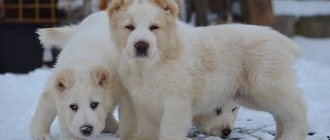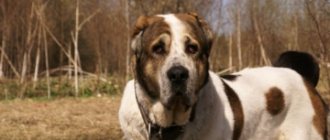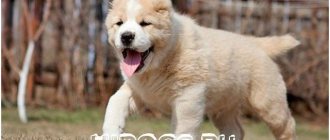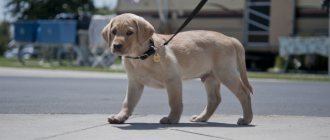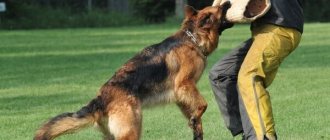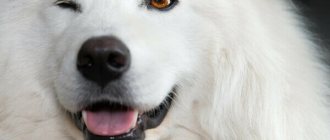Alabai or Central Asian Shepherd is a breed of dog with developed intelligence and a specific character. By adhering to the rules in raising a pet, the owner will raise a faithful friend. Raising and training the Alabai are two different processes. The first is aimed at acquiring social qualities, the second is training in special skills, for example, security.
Alabai training: features of training
Features of raising an Alabai puppy
Dog training begins from the moment it appears in the family. You can read more about the breed itself, its characteristics and history, and caring for the Alabai in a special article on our website. Puppies are sold at two months old. At this age they respond well to education. There are features of animal socialization that you need to pay attention to:
- The Alabai puppy needs to be immediately made clear who the “leader” is, otherwise he will feel like he’s in charge.
- The pet builds a hierarchy. The main thing is the owner. It is important to show the role of household members so that the “Asian” does not feel second to the “leader”. Such dogs, who have not received proper training, growl at children and old people. This is how their intellect works, they consider themselves more important.
- From the first days the puppy is taught to be prohibited. The skill is important, but it is important not to overdo it so that the dog does not grow up too cautious.
Already as a puppy, Alabai should clearly learn the word “No”
- You definitely need to play with the baby, but at the same time clearly delimit the time for games, education, and feeding.
- You can’t be too gentle with a small Alabai. The owner must be persistent.
- The puppy should not be beaten, otherwise the older dog will become aggressive and stop obeying.
- It is better to choose an enclosure for your pet. The Central Asian Shepherd is not a chain dog or a lap dog.
An open-air enclosure is preferable to four walls, in which the Alabai will be cramped
If you decide to make an enclosure for an alabai with your own hands, then below is a brief step-by-step construction instruction.
Do-it-yourself aviary for Alabai
It is necessary to decide what qualities the owner wants to cultivate in the pet even before its appearance. Training a security guard is different from training a companion dog. Be sure to take into account the puppy’s natural characteristics and his type of temperament. A naturally evil animal will not become a good friend for an elderly person.
How to train an Alabai for various purposes
The training method directly depends on the tasks assigned to the pet. They are initially guards, since in principle their main function is the protection of pastures and livestock. In order for an Alabai to become not just a security guard, but also perform work functions, it will take quite a long time to train him.
Working in the pasture
Herding qualities for working in the pasture must begin to be cultivated from 2 months. To do this, the farmer should take the baby with him to field work and allow him to study the pasture. Only when all the commands have been mastered, it is necessary to begin training the “Drive” command. At this time, it is important to carefully monitor that the alabai does not grab the sheep, but only drives them.
Guarding the herd is the primary task of this dog.
For security
Security functions are best taught in Asia by a specialist. The dog handler will teach the dog not only to guard the perimeter entrusted to him, but also to pursue the trespasser. Another function that needs to be instilled in a guard pet is protection of the owner.
Human mistakes when training an Alabai puppy
The main mistake is the owner biting the puppies during play. It is important to understand that the dog grows very quickly and such pranks can have very serious consequences. At the first sign of aggression, the baby should be grabbed by the withers and shaken a little. In this way the mother punishes the puppy.
How do they start raising Alabai?
A two-month-old puppy that looks like a bear cub evokes affection and a desire to cuddle and play. But already at this age you need to lay the foundations for a comfortable life with an adult dog. Socialization of an Asian begins with determining the feeding regime. Based on it, time is set for games, walks, and training. At the same time, the puppy is accustomed to a leash, collar and enclosure.
Following a clear schedule in feeding, playing and training will allow you to discipline the Alabai from childhood
The next important point is establishing contact. Until two months old, the baby lived with his mother; she was his leader. After the Alabai enters the family, the owner must assert his authority. This begins before 6 months of age; later the process becomes more complicated. How does this happen? Nature dictates that a puppy follows a large moving object. The owner takes him outside, lets go of the leash and leaves. The pet runs after him, the man crouches, strokes and praises the dog. When danger appears, such as other dogs, the owner protects the puppy. The baby accepts the authority of the one with whom he feels safe.
It is important for a puppy to feel in the owner the same protector as his mother was.
These walks are done every day. Over time they become longer. When your pet gets used to the area, you can change direction.
The next stage is the development of unconditional submission. The dog must be obedient in all circumstances. The “Asian” senses the owner’s mood by the intonation of speech. Dissatisfaction and the desire to rein in the pet should sound stern. The words must contain the sound “r”. Shouting has no effect on a balanced Alabai, since the dog does not understand what is happening. Unconditional obedience is important to develop before the age of 9 months.
A nine-month-old alabai is already indistinguishable from an adult, and an appropriate approach to it is required
Character and temperament
Raising an Alabai, on the one hand, is a very productive activity, since these dogs naturally have a lively mind and intelligence. But if you look at it from the other side, then you have hard and painstaking work ahead of you, since the dog’s excessive independence and his tendency to disobey can become a serious problem for you. The independence of such dogs is genetic: they were once bred for the purpose of herding sheep and protecting numerous herds.
These large animals could even cope with wolves, but what is important is that they grazed and protected livestock from threats not only on the orders of the owner, but also alone. Willpower and independence were valued before, but now they are becoming the first serious obstacle to establishing psychological contact between a person and an Alabai. This is what you will need to do first.
Training an Alabai at home will be truly effective if you initially show your superiority over the dog. By allowing your dog to disobey once, you will thereby accept his independent model of behavior. There is no punishment - there will be no obedience from the alabai. To avoid such a situation, try to create not particularly comfortable situations for the puppy from an early age: take him for a walk to unfamiliar places, carry him in a car or public transport. Once in a strange atmosphere, the baby will be confused, and in the meantime you will calmly demonstrate your leadership qualities. Thus, from a young age the puppy will remember who is boss in the house.
Related article: To what age does an Alabai dog grow?
The main stages of raising an Alabai puppy
Table 1. Raising Alabai in the first months
| Action | Details |
| Accustoming to a nickname | The process begins after contact is established. The nickname is used to call the puppy for feeding or playing. The name is spoken while stroking. It is important to form positive associations with the nickname. At the moment when the puppy needs to be tamed, the nickname is not used |
| Meet the “Come to me!” team | The command is pronounced simultaneously with the nickname in a calm voice. Later the words “Come to me!” help identify hosts. For following the command, the puppy is petted and given a treat. If the pet is in no hurry to approach, the owner needs to sit down or run away. Such actions arouse interest or a desire to run after. When the puppy finally runs up, you need to praise him |
| Learning to go to a place on command | While the puppy is small, the command “Place!” use it so that it does not interfere. A rug is provided for the puppy. They take the pet to this bedding and say “Place.” Next, on command, the “Asian” must lie down or sit on this mat. The puppy is rewarded for obedience with a treat. If the dog is not taught a place in time, it will choose it on its own and then it will have to be retrained |
| Teaching the command “Fu!” | It is common for a puppy to pick up objects on the street that can harm him. To prevent this from happening, he must navigate when this cannot be done. They master the command at home. If the puppy takes a prohibited object in its teeth, they pronounce a command and take it away. If the pet takes this item again, the command “Fu!” They give it more strictly and press on the dog’s sacrum. As soon as the command is completed, remove the hand from the sacrum, praise and encourage the alabai |
| Teaching the “No!” command | A command means a ban on a particular action. Completion is achieved through repeated repetitions. |
A puppy that has mastered the above actions is easier to train and learn the commands: “Lie down!” , "Sit!" , “Voice!”, “Quiet!”, “Nearby!”, “Forward!”.
Manipulations with food are effective at all stages of education. Actions help to form the desired model of dog behavior. The character of a pet is formed from 9 months to 3 years.
Remember that treats should be handled carefully, otherwise the puppy will quickly get fed up
The dog is not fed in a noisy place; a place for the bowl is allocated in a secluded corner. With the help of food, all family members establish contact with the pet. Exercises with a bowl train endurance. Before serving food, the owner makes sure the puppy sits down and waits. If he begins to jump impatiently, then the bowl is demonstratively taken away. When the puppy sits down, immediately give him a bowl of food.
It is acceptable to make changes to the pronunciation of commands if you are not preparing your pet for a show.
If the dog is raised only for itself, then you can use other words to indicate commands. Common expressions are needed to pass the standards.
Important points in education
- Alabais are excellent guards; these qualities are in their blood. A young dog may exhibit them in an inappropriate situation (for example, growling at others in a crowded place, preventing household members from entering the owner’s house or room). Such manifestations in a puppy must be suppressed. As an adult, it is difficult to cope with such behavior.
Alabais show themselves as guardians almost from the cradle
- To maintain authority, the owner should enter the gate or door first, then let the dog in.
- An Alabai puppy is taken for a walk on a leash, even if it is still small and is not capable of causing harm to others. An adult dog is not allowed out without a muzzle.
Wearing a muzzle outside the home is essential for such a strong and willful breed.
- The Central Asian Shepherd can think, so it must always understand why it is following a command. At first it’s praise and treats.
- Alabai is not taught the “Fetch!” command. This breed does not have the reflex to fetch an abandoned item.
Video - Basics of training an Alabai puppy
Puppy training
You need to start training your puppy as soon as he gets into your home - most often this happens at about 2 months. The main quality that the owner needs to show while training the Alabai is calmness. The puppy perceives screaming and physical punishment as weakness. And a weak person, in principle, cannot be a leader. If an animal needs to be punished, it is enough to shake it by the withers, imitating a mother dog. In this case, you need to say “no” or “ugh”.
Up to 7-8 months, the dog should gradually learn the commands: “Come to me!”, “Lie down!”, “Sit!”, “Nearby!”, “Walk!”, “Stand!”, “No!”, “Place! » Commands should not be learned at the same time. In addition, the Alabai needs more time to understand each command than other breeds. Training an Alabai puppy is a long and difficult task, but he will remember everything he has learned for the rest of his life, demonstrating in the future the impeccable execution of commands.
Differences in the upbringing of males and females
Little stubborn people at first refuse to follow commands and obey the rules. This applies to dogs of both sexes. Males quickly recognize the leadership of their owner. After several attempts at disobedience and evasion of orders, the males obey.
Despite their straightforward nature, Alabais can be cunning and evade commands.
Females take longer to learn obedience. The “Asian” first snaps, then realizes that it is useless and begins to be cunning. By avoiding following the command, the dog pretends to be weak and sick. When the female understands that the owner has taken pity on her and no longer demands submission, she again becomes cheerful and playful. With bitches, the owner needs to show even more patience and perseverance.
How to raise an adult dog?
An adult Alabai ends up in a new family when it loses its previous owners. An enclosure will be immediately organized for him. In addition, the yard must be surrounded by a strong fence to prevent the new 80-pound resident from escaping.
First one of the household members establishes contact. To do this, he goes out into the yard and lets the dog out. The person must behave as if he does not notice the dog, while furtively observing him. The dog's attempts to take a step towards the new owner should be met with an approving look.
Getting to know the Alabai should not be accompanied by tenderness - the dog should be given time to look around
Female shepherd dogs get used to a new home and environment faster than males. It is considered normal behavior if at first the dog refuses food and does not allow petting or wearing a collar. During the adaptation process, you cannot use brute force: pull the leash, put on a strict collar. Also, do not insist on eating food. All these actions lead to the animal’s aggression and do not contribute to establishing contact.
If the Alabai is handled correctly, it will treat household members kindly and calmly
An adult Alabai is taken outside the yard after it has adapted to a collar and leash. To prove himself as a leader, the owner takes the dog with him to unfamiliar places. Until this moment, the dog is allowed out of the enclosure for a walk around the yard.
Training and teaching commands
To begin with, you should establish psychological contact with your new ward. When the little tailed creature gets used to you a little and begins to trust you, it’s time to start training.
Among the basic commands that should be taught to your pet are the following:
- "Sit!";
- "Near!";
- "Stand!";
- "Lie!";
- "Place!";
- "Walk!".
You need to train the Alabai step by step. Wait patiently until the animal explains the new command to itself and agrees to carry it out. When this becomes a habit for him, you can safely move on to learning a new skill. Please also take into account the fact that it is advisable to conduct training in a calm atmosphere, so that the animal is not distracted by anything.
Full results should be expected from a dog already at the age of 6–7 months. She must certainly learn basic commands, be accustomed to walking with a muzzle, and also calmly respond to the owner’s touch.
Before starting training with an Alabai, you need to consult with a dog handler who will give advice on how to properly raise an Alabai and what commands to start with. When starting classes, it is important to remember that training an Alabai puppy should not be like a game.
"To me"
This is one of the most important commands in controlling a dog. When practicing it with a puppy, you need to be extremely scrupulous. An adult Alabai is a very strong dog, and it will not be possible to restrain him. But if the dog clearly understands the “come to me” command, then there should be no difficulties in the future.
The puppy is allowed to walk on a long leash. During the walk, they give the command “come to me” and shorten the leash. This is how the pet understands what the owner wants from him. After the command is already familiar to the dog, you need to achieve independent execution.
Important! Every time the command is executed correctly, you must not forget to praise the puppy, caress it or give it a treat.
In the process of practicing a command, in no case should you scold him after the puppy approaches the owner. The pet will develop a negative attitude, which will lead to complete disregard for the command.
"Place"
From the first days of being in a new home, the Alabai must have its own bedding and learn the “place” command. Having your own space will help you adapt faster. The “place” command is also used when the puppy is in the way or doing something prohibited. In these cases, you need to say it and put the puppy on the mat. These are the basics of discipline that the puppy must learn in the first months.
We invite you to read: Drontal for cats - instructions for use
"Sit" and "lie down"
Mastering these commands makes life much easier for a person interacting with their pet. The puppy must first learn the “sit” command. Raise a treat over the puppy's head and slowly move your hand slightly behind the dog's head. In order not to lose sight of the treat, the puppy will certainly sit down. At this moment, you need to praise him and give him a treat.
For your information! It is recommended to practice the technique before walking the dog or feeding it, but you should not repeat the command several times in a row.
As soon as the “sit” command is brought to automaticity, you can move on to the “lie down” command. To do this, you need to sit the puppy near your left leg and, holding the treat in your outstretched hand, lower it while giving the command. Trying to reach the treat, the Alabai puppy will lie down.
"Ugh!" or "you can't"
When outside the home, the Alabai may show aggression towards other animals or an increased interest in moving cars. To stop this, you need the command “fu” or “no”. It must be pronounced firmly, while simultaneously tugging on the leash, so that the alabai understands that he has no choice but to obey.
Outdoor training
Some activities need to be done outside:
- Practicing the commands “Ugh!” and “Come to me!” The dog must follow these two basic commands regardless of the circumstances. Alabai is taught to obey commands and not pay attention to external irritants (cats, birds, other dogs).
It is necessary to train the Alabai to hear and notice the owner even in the presence of distractions
- Teaching the command “Road!” With this word, the owner stops the dog in front of the roadway or just a moving car. The command is spoken and insisted on being carried out, even if the road is clear of traffic.
- Executing the command “Barrier!” occurs on the street, since the dog’s size will not allow it to jump over obstacles at home.
- Training to climb stairs.
- Swimming. Alabai are accustomed to water carefully; not all individuals like to swim. The habit is formed gradually, each time taking the shepherd dog a little deeper. This skill is optional, so there is no need to insist on learning.
How to raise as a shepherd
Training a Rottweiler at home
For this purpose, the Central Asian Shepherd Dog is taken to pastures from the age of two months, so that the puppy can become familiar with the territory. After this, they teach the “drive” command, following which the alabai will drive the cattle or force the herd to move in the right direction.
Grazing cattle in the steppe
For your information! It is in the Central Asian Shepherd's blood to protect its territory. She doesn't need to be taught this. During the training process, the owner must develop rules for the dog’s behavior towards strangers. Alabai must learn to detain the intruder without causing him harm, and not to overdo it while protecting the owner. All this is very important, so it is better to seek help from a professional dog handler.
Training methods and scheme
The training process should follow the following pattern: command – praise – treat. During one puppy training session, the scheme is repeated no more than three times. The baby gets tired quickly. New commands are added only after mastering and unquestioning execution of those already learned.
Proper distribution of training hours will avoid overworking the puppy
Traditionally, the following training methods are distinguished:
- encouragement;
- prohibition;
- compulsion.
Table 2. Methods of training Alabai
| Method | Details |
| Promotion | It has two manifestations: praise and treats. It is important to dose encouragement correctly in order to indicate the pet’s growth zone, without depriving him of motivation with too frequent “compliments” |
| Prohibition | Assumes strict systematicity and lack of ambiguity. It should not be allowed that the same action is sometimes permitted and sometimes not. There is no need to introduce unreasonable bans; the dog should not be afraid to take the initiative. |
| Compulsion | The tools of the method are a strict tone, shaking, pressing on the sacrum, pulling on the leash. The unpleasant sensations from these actions stimulate the animal's submission. Physical pain should not be caused to a dog during training. |
How to raise a healthy dog - feeding rules
For the first 10–14 days, the pet should receive the same food that the breeder fed it. This way, you reduce stress levels and avoid indigestion due to a sudden change in diet. Even if you plan to feed the dog “natural”, and the breeder prefers drying, buy food of the same brand with a supply of 15 days, starting from the 10th day, transfer the puppy to the diet of your choice using the admixture method.
Important! When feeding your puppy dry food, it is recommended to soak the granules in warm water 7-10 minutes before serving.
Natural feeding of Alabai puppies involves a diet enriched with proteins and microelements. For proper muscle formation, the baby should receive a menu of 50% meat (up to 15% offal), milk and dairy products, 10–25% cereals, 10–25% vegetables and fruits. Equally important are oils, dairy products, eggs, ocean fish (if the dog likes it) and vitamin supplements for large, fast-growing breeds. Carefully monitor your pet's weight. Obesity, especially at a young age, will lead to joint diseases, and even their physical deformation.
Special training of Alabai
The owner teaches the alabai how to carry out basic and subsequent commands. For special training of given qualities, it is better to contact a specialist.
Training Alabai to work in the pasture
Puppy training begins at 1.5 - 2 months. These dogs take long walks of 2–3 hours. After the Alabai has mastered commands and obedience, he is taught to hurry up animals that are lagging behind or that are far away.
Alabai has shepherd skills in his blood, so learning this craft comes easily to him
The dog handler attaches a 11-13 meter leash to the shepherd dog and walks with her to the lagging animal. Then he says the command “Drive!”, while cracking the whip and pointing in the desired direction. The trainer completely loosens the leash. The dog runs towards the herd, the man moves with it, at the same time praises it, saying: “Okay, drive, good.” The rut is stopped with the command “Come to me!” After achieving the goal, the alabai is given a treat. Success is achieved by repeating the procedure many times. Then the training continues without a leash.
Although the Alabai does not tend to show aggression towards the herd, sometimes a muzzle is required to prevent bites
If a dog without a leash becomes distracted, does not follow commands, or grabs livestock by the legs, the training begins again with a leash.
First, they are taught to hurry up animals that are 10 to 30 meters behind, then at longer distances. If the Alabai is aggressive in nature, then training is carried out with a muzzle and a strict collar.
To control the movement of the herd, the alabai is directed in the direction opposite to the one in which it is necessary to turn. At the command “Drive!” The shepherd runs after the cattle, which have gone a little further than the rest. The animals turn in the right direction, the herd follows them. As soon as the goal is achieved, the shepherd commands “Come to me!”
It is enough to teach the Alabai the basics of driving livestock so that he quickly gains confidence and independence
The rotation of the herd in the desired direction is also regulated by the location of the alabai in front of the herd. The cattle, having reached the shepherd, will turn in the right direction. Such herd management requires considerable endurance from the Alabai. Team "Voice!" used if the herd comes too close to the dog, but does not go in the right direction. A trained Central Asian Shepherd is capable of independently making decisions about catching animals that are lagging behind or wandering to the side, and about turning the herd in the right direction.
Training Alabai for protection
The shepherd dog is taught to guard the house from the age of six months. This skill requires a professional approach. The trainer teaches the dog:
- distrust strangers and bark at them;
- pursue the intruder;
- protect the owner;
- protect the territory and specified objects;
- take a trail, find people and objects.
Only a specialist can develop hunting skills in Alabai
It is important to find a dog handler who has experience working specifically with Alabai. The peculiarity of the breed is that when practicing the skills of defense and attack and the lack of the right approach, the shepherd dog will not grab onto the protected hand, but into the open throat. At the same time, the future security guard is dealt with individually. In a group with other dogs, the Alabai shows aggression and becomes uncontrollable.
Character of Alabai
It is impossible to approach training a Central Asian without knowing the characteristics of his character. Therefore, before you start training, you need to get acquainted with the history of the breed. Initially, CAOs were used to protect flocks of sheep from predators, help gather animals, and protect their owner from trouble. The Alabai themselves primarily took care of their food. Dogs were never trained by anyone: they gained the necessary knowledge from the older individuals in the pack. The group of guards was led by an experienced leader. He could only give up his place to a smarter and stronger dog, losing to him in a single fight.
Thus, when raising an Alabai, it is necessary to take into account that he will obey only the leader. And if for a little puppy you are a priori the main one, then as they grow older this confidence may be shaken, and the Alabai himself will want to become a leader. Therefore, it is necessary to constantly put the puppy in such conditions so that he feels confused and insecure - taking him on various types of transport, walking in different places, etc. Your calmness in all situations will be proof of strength and courage, which means the puppy will be confident. that you are the leader.
